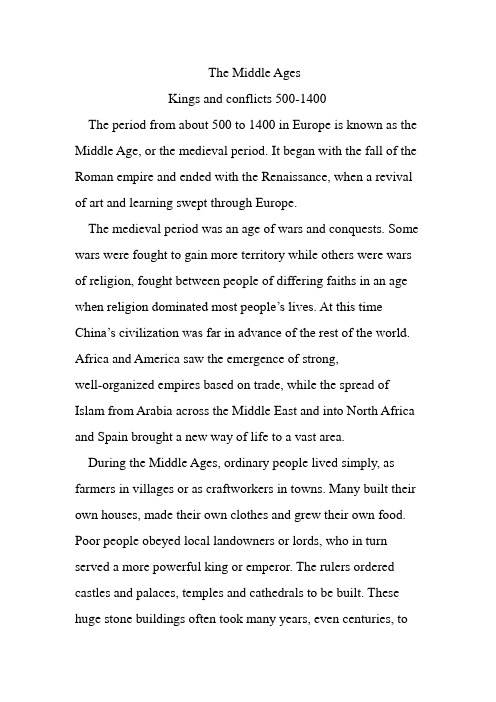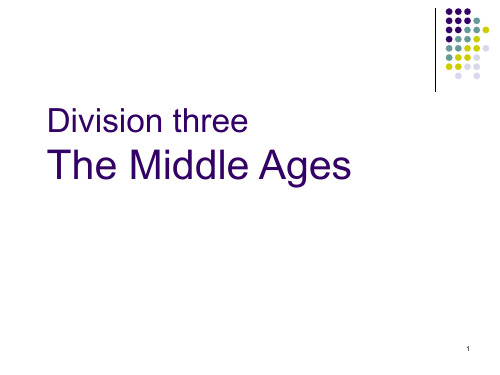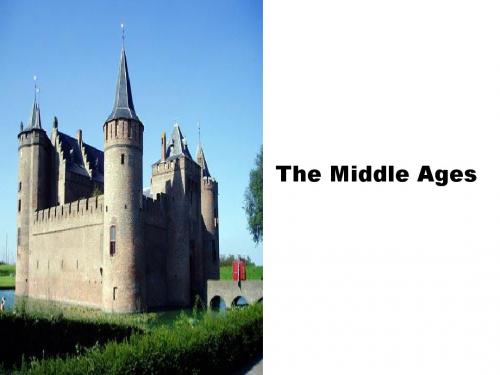英国文学史上笔记-themiddleages
- 格式:docx
- 大小:26.10 KB
- 文档页数:4


第三章中世纪文明The Middle Ages西欧中世纪:476年西罗马灭亡作为开端,至1453年奥斯曼土耳其攻占君士坦丁堡;另一说是1500年,吴于廑先生“海道大通”中世纪的欧洲文明,实质上是一种地域性的封建文明基督教构成了欧洲中世纪精神文化的核心封建西欧的历史分早、晚两个时期:1.封建文明形成与发展时期(5-14世纪)2.封建文明趋向没落、资本主义工业文明萌芽时期(15-17世纪)第一节西欧封建文明的萌发一、欧亚大陆的民族大迁徒3-5世纪,游牧世界对农耕世界大冲击从东到西中国:北方民族南下,匈奴、鲜卑等建立五胡十六国,汉人统治范围压缩到长江以南,偏安东晋。
日耳曼各部落(Barbarian)灭亡了西罗马二、日耳曼人的入侵及其影响1.日耳曼人的入侵恺撒的《高卢战记》与塔西陀的《日耳曼尼亚志》所反映的日耳曼社会原始社会末期氏族部落军事民主制阶段先后建立起了国家组织汪达尔王国、苏维汇王国、西哥特王国、勃良第王国、东哥特王国、法兰克王国2. 民族大迁徒的后果和意义并非单纯的民族迁移或武力征服活动,而是影响了西欧人民此后的历史发展道路,改绘了当时西欧的政治地图,在深刻交融的基础上重组了民族格局日耳曼人的入侵造成混乱,对当时西罗马帝国的社会经济很大破坏野蛮与文明之间的对话与撞击。
古典时代的结束与中世纪的开始日耳曼人的特点:没有国家观念、行政管理机构法律简单,神裁法自然经济日耳曼征服者在各方面不同程度地受到罗马文明的影响,皈依罗马天主教,反映了当时蛮族罗马化的趋向。
日耳曼人建立的王国:东哥特王国、汪达尔王国、法兰克王国三、法兰克王国Kingdom of Franks1.墨洛温王朝(481-751年)496年克洛维正式皈依了基督教罗马教会,日耳曼因素与罗马人结合的起点2.查理·马特Charles Martel的采邑制改革宫相mayor of the palace采邑beneficium本意为“承担义务的封地”将土地以采邑的形式分封给参战的将士,条件是为中央政权服军役。

The Middle AgesKings and conflicts 500-1400The period from about 500 to 1400 in Europe is known as the Middle Age, or the medieval period. It began with the fall of the Roman empire and ended with the Renaissance, when a revival of art and learning swept through Europe.The medieval period was an age of wars and conquests. Some wars were fought to gain more territory while others were wars of religion, fought between people of differing faiths in an age when religion dominated most people’s lives. At this time China’s civilization was far in advance of the rest of the world. Africa and America saw the emergence of strong,well-organized empires based on trade, while the spread of Islam from Arabia across the Middle East and into North Africa and Spain brought a new way of life to a vast area.During the Middle Ages, ordinary people lived simply, as farmers in villages or as craftworkers in towns. Many built their own houses, made their own clothes and grew their own food. Poor people obeyed local landowners or lords, who in turn served a more powerful king or emperor. The rulers ordered castles and palaces, temples and cathedrals to be built. These huge stone buildings often took many years, even centuries, toconstruct.Few people travelled far from their homes. Those who did venture into foreign lands included merchants, soldiers and a few bold explorers who wrote accounts of their travels. Few people could read or write, and learning was passed down by word of mouth. In Europe, the monasteries were centres of learning, while in Asia the Chinese and Arabs led the way in science and technology, medicine and astronomy.。



The Middle AgesThe King王Duke爵Marquis侯Earl伯Viscount子Baron男The Middle Age(dark age)From the fall of the Roman Empire to the beginning of modern European civilization.From 5th to 15th centuryMedieval(中世纪的) civilization (Western Europe) VS. Greco-Roman civilization (Italy, Greece, Syria叙利亚and North Africa)(地中海文化) Political Power was divided among a hierarchy 等级制度of interdependent governments rather than concentrated in a world empire 权帝or a group of sovereign独立自主的national states;●Political power was divided among a hierarchy of interdependentgovernments rather than concentrated in a world empire of a group of sovereign national states;●The church was independent of secular authority世俗的,非教会的权威; it set the standards and defined the goals for all humanactivity;●In economics there was neither state regulation货架调控norlaissez-faire自由放任政策;instead local custom controlled farmers artisans手工艺and merchants 商人in the interest of the whole community;●(the weakness or the absence of large political units increased thecohesiveness内聚of small groups.)●Gothic art, chivalric 骑士制度poetry, scholastic 教育的经院哲学的philosophy, and the university system of educationMedieval Social Strata 社会阶层●The nobility 贵族●The church●The commoner 平民●Birth, wealth, profession, personal ability(late 14th century)● A growing and prosperous 兴旺的,繁荣的middle classGeoffrey Chaucer(1340-1400) 杰佛利·乔叟-----(约1340-1400)英国代表作家,现实主义文学的奠基者。
English Literaturethe Middle Ages (medieval period) to 1485The Old English (to 1066)The Middle English (to 1485)From the collapse of the Roman empire to the RenaissanceA period of enormous historical, social and linguistic change.In fact, "art and literature flourished during the Middle Ages, rooted in the Christian culture that preserved , transmitted, and transformed classical tradition.The Old English PoetryThe bulk of old English literature deals with religious subjects and is mostly drawn from Latin resources.A small amount of secular poetry, including epic poems like Beowulf.The subject matter of his verse is sometimes of great antiquity, concerning the legendary or historical figure who lived before the Anglo-Saxon conquest of England.(e.g. Pagan, Hellenic heroic world)Thus, the heroic world was remote from the Christian world of Anglo-Saxon England. Moreover, the heroic code is difficult to reconcile with christian doctrines such as "forgive those that trespass against us." and "all they that take the sword shall perish with the sword"The poetry is predominantly harsh (e.g struggle in battles)Grave, decorous(serious and polite and elegant)古英语时期,文学语言很高雅,庄重,远离现实,这不同于中世纪。
The Middle AgesThe Anglo-Saxon Period (449~1066)Reference: 1) The literature of early period falls naturally into two divisions, Pagan and Christian.(异教徒文学和基督徒文学) Pagan represents the poetry which the Anglo-Saxons probably brought with them in the form of oral sagas (口头诗歌), the crude material out of which literature was slowly developed on English soil; Christian represents the writings developed under the teaching of the monks.(僧侣)2) Among the early Anglo-Saxon poets we may mention Caedmon(开德蒙the first important religious poet in English literature) who lived in the latter half of the 7th century and wrote a poetic paraphrase of the Bible; Cynewulf(琴涅武甫), the author of poems on religious subjects.Beowulf:the national epic of the Anglo-Saxons, represents the spirit of paganArtistic features: 1) Using alliteration押头韵(Definition of alliteration: a rhetorical device, meaning some words in a sentence begin with the same consonant sound)2) Using metaphor and understatement (Definition of understatement: expressing something in a controlled way. Understatement is a typical way for Englishmen to express their ideas. 保守的陈述)Things and Figures mentioned: Beowulf (the Teutonic hero) Hrothgar (the King of the Danes)Heorot 鹿厅Grendel (the half-human monster)Beacon (Beowulf墓上所建) Scyld 赛亚德Definitions of important literary terms:1.1)Epic (heroic poetry): An epic is a long oral narrative poem that operates on a grand scale and deals with legendary or historical events of national or universal significance. Most epics deal with the exploits(功勋)of a single individual and also interlace(交织、交错)the main narrative with myths, legends, folk tales and past events; there is a composite(复合的)effect, the entire culture of a country cohering in the overall experience of the poem. Epic poems are not merely entertaining stories of legendary or historical heroes; they summarize and express the nature or ideals of an entire nation at a significant or crucial period of its history. 史诗是长篇口头叙事诗,内容广泛,通常以重要传说或者重大历史事件为题材。
大部分的史诗歌颂个人的英雄事迹,同时也在叙述中插入神话、传说、民间故事以及历史事件;一个民族的整体文化与全诗所讲的经历紧密联系,造成一种复合的效果。
史诗不仅仅是愉悦人的传奇故事或者历史英雄事迹,它们总结以及表达了一个民族在其历史上一个重要或者关键时期的本质或者理想。
(简要地说就是:a long narrative poem telling about the deeds of a great hero and reflecting the values of the society from which it originated.)2)Alliteration (head rhyme or initial rhyme): the repetition of the same sounds—usually initial consonants(辅音) of words or stressed syllables(音节)—in any sequence of neighbouring words. Now an optional and incidental(附带的) decorative effect in verse(诗) or prose(散文), it was once a required element in the poetry of Germanic languages (including old English and old Norse挪威语) and in Celtic verse (where alliterated sounds could regularly be placed in positions other than除了the beginning of a word or syllable). Such poetry, in which alliteration rather than rhyme is the chief principle of repetition, is known as alliterative verse; its rules also allow a vowel sound to alliterate with any other vowel.Other works: 1)Bede比德(excellent writer in Anglo-Saxon period)-<Historia Ecclesiastica Gentis Anglorum>英吉利人教会史2) King Alfred the Great艾尔弗雷德大帝(英国散文之父)-<Anglo-Saxon Chronicle>盎格鲁撒克逊编年史The Anglo-Norman Period (1066~1350)Reference: 1)The literature which Normans brought to England is remarkable for its bright, romantic tales of love and adventure, in marked contrast with the strength and somberness(昏暗、暗淡) of Anglo-Saxon poetry.2)English literature at the Anglo-Norman period was a combination of French and Saxon elements.Works: Sir Gawain and the Green Knight (Alliteration)Things and Figures mentioned: Gawain(the knight) Arthur(the king) Camelot(Arthur’s palace)The Green Knight(a gigantic one) the magic green girdle(绿腰带) Definitions of important literary terms:1)Canto(诗章): a subdivision of an epic or other narrative poem, equivalent to a chapter in aprose work.2)Legend:A story or group of stories handed down through popular oral tradition, usuallyconsisting of an exaggerated or an unrealiable account of some actually or possibly historical person—often a saint,monarch, or popular hero. Legends are sometimes distinguishing from myths in that they concern human beings rather than gods, and sometimes they have some sort of historical basis whereas myths do not, but these distinctions are difficult to maintain consistantly. This term was originally applied to accounts of saints’ lives, but is now mainly applied to fanciful tales of warriors (eg. King Arthur and his knights), criminals(eg. Robin Hood), and other sinners; or more recently to those bodies of biographical rumour and embroidered anecdote surrounding dead film stars and rock musicians(eg. John Lennon)3)Arthurian Legend: A group of tales (in several languages) that developed in the Middle Agesconcerning Arthur, semi-historical king of Britans, and his knights. The legend is a complex weaving of ancient Celtic mythology(神话) with later traditions around a core of possible historical authenticity(真实性).Geoffery Chaucer 杰弗里•乔叟1340(?)~1400Reference: 1)首创“英雄双韵体”Heroic Couplet,英国文学史上首先用伦敦方言写作。